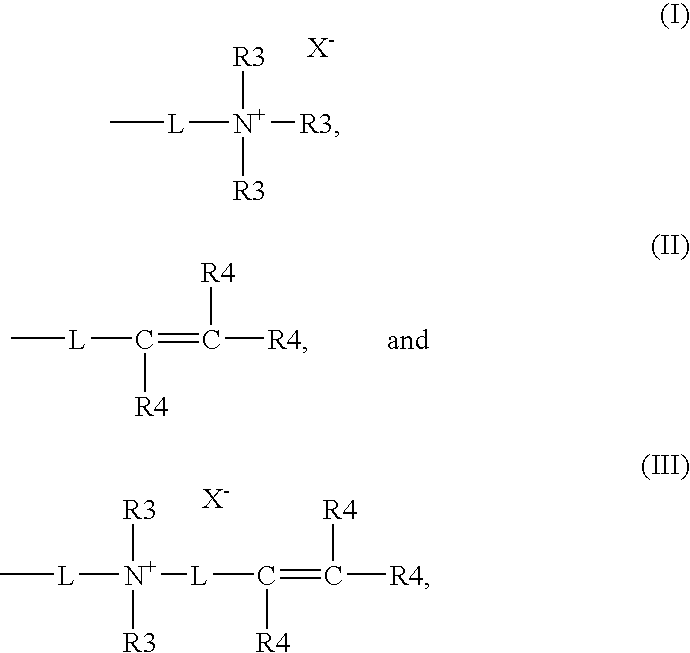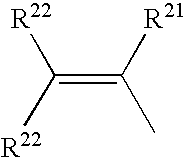Siloxane prepolymer containing pendant cationic and polymerizable groups
a technology of cationic and polymerizable groups and siloxane, which is applied in the field of polymer compositions, can solve the problems of poor soluble water content, difficult copolymerization and process using standard hydrogel techniques, etc., and achieves the effects of high water hydration content, difficult copolymerization and process, and significant hydrophilic character
- Summary
- Abstract
- Description
- Claims
- Application Information
AI Technical Summary
Benefits of technology
Problems solved by technology
Method used
Image
Examples
Embodiment Construction
[0009]In a first aspect, the invention relates to random copolymers of formula (I):
wherein R1 is selected from one of the following formulae:
x is 0 to 1000, y is 1 to 300, L can be the same or different and is selected from the group consisting of urethanes, carbonates, carbamates, carboxyl ureidos, sulfonyls, a straight or branched C1-C30 alkyl group, a C1-C30 fluoroalkyl group, a C1-C20 ester group, an alkyl ether, cycloalkyl ether, cycloalkenyl ether, aryl ether, arylalkyl ether, a polyether containing group, an ureido group, an amide group, an amine group, a substituted or unsubstituted C1-C30 alkoxy group, a substituted or unsubstituted C3-C30 cycloalkyl group, a substituted or unsubstituted C3-C30 cycloalkenyl group, a substituted or unsubstituted C5-C30 aryl group, a substituted or unsubstituted C5-C30 arylalkyl group, a substituted or unsubstituted C5-C30 heteroaryl group, a substituted or unsubstituted C3-C30 heterocyclic ring, a substituted or unsubstituted C4-C30 heterocy...
PUM
| Property | Measurement | Unit |
|---|---|---|
| thickness | aaaaa | aaaaa |
| width | aaaaa | aaaaa |
| gauge length | aaaaa | aaaaa |
Abstract
Description
Claims
Application Information
 Login to View More
Login to View More - R&D
- Intellectual Property
- Life Sciences
- Materials
- Tech Scout
- Unparalleled Data Quality
- Higher Quality Content
- 60% Fewer Hallucinations
Browse by: Latest US Patents, China's latest patents, Technical Efficacy Thesaurus, Application Domain, Technology Topic, Popular Technical Reports.
© 2025 PatSnap. All rights reserved.Legal|Privacy policy|Modern Slavery Act Transparency Statement|Sitemap|About US| Contact US: help@patsnap.com



